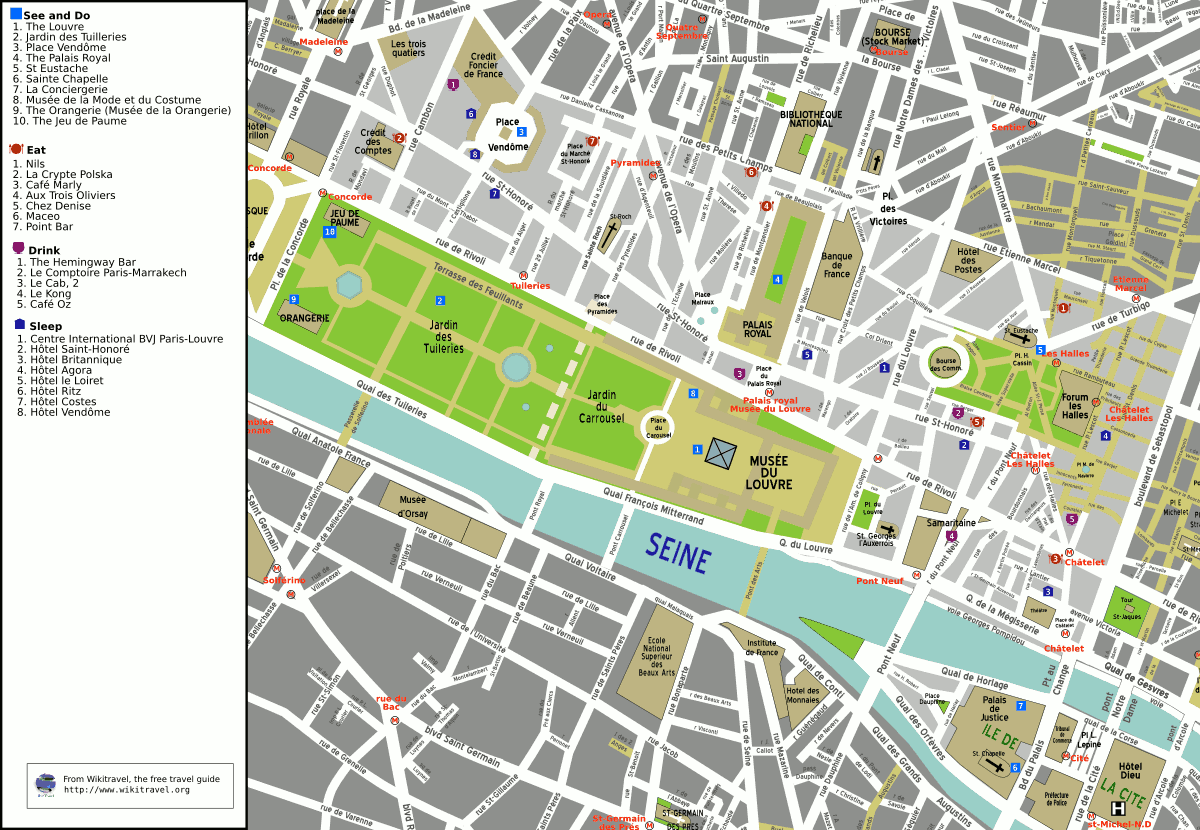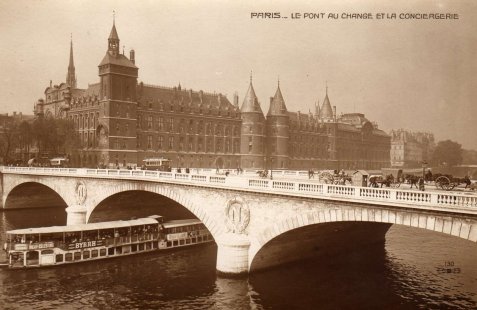1st Arrondissement

Situated principally on the right bank of the River Seine, it includes the west end of the Île de la Cité. The arrondissement is one of the oldest in Paris, the Île de la Cité having been the heart of the city of Lutetia, conquered by the Romans in 52 BC, while some parts on the right bank (including Les Halles) date back to the early Middle Ages.
It is the least populated of the city's arrondissements and one of the smallest by area, a significant part of which is occupied by the Louvre Museum and the Tuileries Gardens. Much of the remainder of the arrondissement is dedicated to business and administration.
Bridges
- Pont Neuf: is the oldest standing bridge across the river Seine in Paris, France. It stands by the western (downstream) point of the Île de la Cité, the island in the middle of the river that was, between 250 and 225 BC, the birthplace of Paris, then known as Lutetia, and during the medieval period, the heart of the city.
The name Pont Neuf was given to distinguish it from older bridges that were lined on both sides with houses. It has remained after all of those were replaced.
- Pont Des Arts: The Pont des Arts or Passerelle des Arts is a pedestrian bridge in Paris which crosses the River Seine. It links the Institut de France and the central square (cour carrée) of the Palais du Louvre, (which had been termed the "Palais des Arts" under the First French Empire).
Important Sites
Introduction: The 1st arrondissement forms much of the historic centre of Paris. Situated principally on the right bank of the River Seine, it also includes the west end of the Île de la Cité. The arrondissement is one of the oldest in Paris, the Île de la Cité having been the heart of the city of Lutetia, conquered by the Romans in 52 BC, while some parts on the right bank (including Les Halles) date back to the early Middle Ages.
It is the least populated of the city's arrondissements and one of the smallest by area, a significant part of which is occupied by the Louvre Museum and the Tuileries Gardens. Much of the remainder of the arrondissement is dedicated to business and administration.
- -- Arc de Triomphe de l'Étoile: is one of the most famous monuments in Paris. It stands in the centre of the Place Charles de Gaulle (originally named Place de l'Étoile), at the western end of the Champs-Élysées. It should not be confused with a smaller arch, the Arc de Triomphe du Carrousel, which stands west of the Louvre. The Arc de Triomphe honors those who fought and died for France in the French Revolutionary and the Napoleonic Wars, with the names of all French victories and generals inscribed on its inner and outer surfaces. Beneath its vault lies the Tomb of the Unknown Soldier from World War I.
- -- Avenue des Champs-Élysées: is a street in Paris with cinemas, cafés, luxury specialty shops and clipped horse-chestnut trees, the Champs-Élysées is arguably one of the world's most famous streets, and is one of the most expensive strips of real estate in the world. Several French monuments are also on the street, including the Arc de Triomphe and the Place de la Concorde. The name is French for Elysian Fields, the place of the blessed dead in Greek mythology. According to a much used description, the Champs-Élysées is "la plus belle avenue du monde" ("the most beautiful avenue in the world"). -- {Elysium}
- -- Châtelet-Les-Halles: A central underground station of Paris's express commuter rail system, the RER, that lies beneath the Forum des Halles shopping precinct.
- -- Comédie-Française: or Théâtre-Français is one of the few state theaters in France. It is the only state theater to have its own troupe of actors. The company's primary venue is the Salle Richelieu. The or Théâtre-Français is one of the few state theaters in France. It is the only state theater to have its own troupe of actors. The company's primary venue is the Salle Richelieu. The theater is part of the Palais-Royal complex and located at 2 rue de Richelieu on the Place André-Malraux in the 1st arrondissement.
- -- Galerie nationale du Jeu de Paume: is a museum of contemporary art in the north corner (west side) of the Tuileries Gardens next to the Place de la Concorde in Paris.
- -- Île de la Cité: is one of two remaining natural islands in the Seine within the city of Paris (the other being the Île Saint-Louis). It is the center of Paris and the location where the medieval city was re-founded.
- -- La Conciergerie: is a former royal palace and prison in Paris, located on the west of the Île de la Cité (literally island of the city). It is part of the larger complex known as the Palais de Justice, which is still used for judicial purposes. Hundreds of prisoners during the French Revolution were taken from La Conciergerie to be executed on the guillotine at a number of locations around Paris.
- -- The Louvre: is one of the world's largest museums and a historic monument in Paris, France. A central landmark of the city, it is located on the Right Bank of the Seine in the 1st arrondissement. -- {Elysium}
- -- Forum des Halles: An underground modern shopping precinct whose open air center area is below street level, like a sunken garden, and contains sculptures, fountains, and mosaics.
- -- Palais de Justice de Paris: is located upon the Île de la Cité in central Paris. Thee palace is built on the site of the former royal palace of Saint Louis, of which the Sainte Chapelle remains. Thus the justice of the state has been dispensed at this site since medieval times. From the sixteenth century to the French Revolution this was the seat of the Parlement de Paris. The Palais also contains the ancient structure of the Conciergerie, a former prison, now a museum, where Marie Antoinette was imprisoned before being executed on the guillotine.
- -- Palais-Royal de Paris: was originally called the Palais-Cardinal, the palace was the personal residence of Cardinal Richelieu. The architect Jacques Lemercier began his design in 1629; construction commenced in 1633 and was completed in 1639. Upon Richelieu's death in 1642 the palace became the property of the King and acquired the new name Palais-Royal.
- -- Place Charles de Gaulle: historically known as the Place de l'Étoile. It is a large road junction in Paris, the meeting point of twelve straight avenues (hence its historic name, which translates as "Square of the Star") including the Champs-Élysées. It was renamed in 1970 following the death of General and President Charles de Gaulle. It is still often referred to by its original name, and the nearby metro station retains the designation Charles de Gaulle - Étoile.
- -- Place du Châtelet: is a public square in Paris, on the right bank of the river Seine, on the borderline between the 1st and 4th arrondissements. It lies at the north end of the Pont au Change, a bridge that connects the Île de la Cité, near the Palais de Justice and the Conciergerie, to the right bank. The name "Châtelet" refers to the stronghold, the Grand Châtelet, that guarded the northern end of the Pont au Change, containing the offices of the prévôt de Paris and a number of prisons, until it was demolished in 1802-10.
- -- Place Dauphine: is a public square located near the western end of the Île de la Cité in the first arrondissement of Paris. It was initiated by Henry IV in 1607, the second of his projects for public squares in Paris, the first being the Place Royale (now the Place des Vosges). He named it for his son, the Dauphin of France and future Louis XIII, who had been born in 1601. From the "square", actually triangular in shape, one can access the middle of the Pont Neuf, a bridge which connects the left and right banks of the Seine by passing over the Île de la Cité. A street called, since 1948, Rue Henri-Robert, forty meters long, connects the Place Dauphine and the bridge. Where they meet, there are two other named places, the Place du Pont Neuf and the Square du Vert Galent.
- -- Place des Pyramides: is a public square in the 1st arrondissement; it is located in the middle of the Rue de Rivoli, at its intersection with the Rue des Pyramides and Avenue du General Lemonnier, at the western end of the Tuileries Garden. The square was named for the street, Rue des Pyramides, and the street was named for the Battle of the Pyramids, a Napoleonic victory achieved in Egypt in 1798.
- -- Place des Victoires: is a circular place, located a short distance northeast from the Palais Royal and straddling the border between the 1st and the 2nd arrondissements. The Place des Victoires is at the confluence of six streets: Rue de la Feuillade, Rue Vide Gousset, Rue d'Aboukir, Rue Étienne Marcel, Rue Croix des Petits Champs, and Rue Catinat.
- -- Place Vendôme:is a square in the 1st arrondissement of Paris, France, located to the north of the Tuileries Garden and east of the Église de la Madeleine. It is the starting point of the Rue de la Paix. It is famous for its deluxe hotels such as Hôtel Ritz, Hôtel de Rambouillet, The Westin Paris – Vendôme, Hôtel de Toulouse, Hôtel du Petit-Bourbon, Hôtel Meurice, and the Hôtel Regina. Located within the 1st Arrondissement.
- -- Théâtre du Châtelet: is a theatre and opera house, located in the place du Châtelet in the 1st arrondissement of Paris.
- -- Théâtre du Palais-Royal: is a 950-seat Parisian theatre at 38 rue de Montpensier, located at the northwest corner of the Palais-Royal in the Galerie de Montpensier at its intersection with the Galerie de Beaujolais.
- -- Tuileries Garden: is a public garden located between the Louvre Museum and the Place de la Concorde in the 1st arrondissement of Paris. Created by Catherine de Medicis as the garden of the Tuileries Palace in 1564, it was eventually opened to the public in 1667, and became a public park after the French Revolution. In the 19th and 20th century, it was the place where Parisians celebrated, met, promenaded, and relaxed. -- {Elysium}
